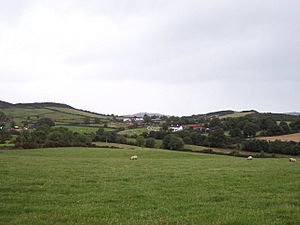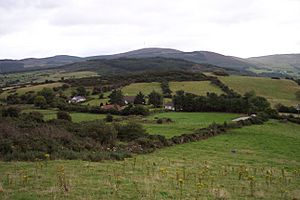Battle of Moyry Pass facts for kids
Quick facts for kids Battle of Moyry Pass |
|||||||
|---|---|---|---|---|---|---|---|
| Part of the Nine Years' War | |||||||
|
|||||||
| Belligerents | |||||||
| Commanders and leaders | |||||||
| Hugh O'Neill | Lord Mountjoy | ||||||
| Strength | |||||||
| 3,000–4,000 | 4,000–5,000 | ||||||
| Casualties and losses | |||||||
| 1-200 killed | 4-500 killed, 400 wounded, several hundred dead from disease | ||||||
The Battle of Moyry Pass was a big fight during the Nine Years' War in Ireland. It happened in September and October 1600. The battle took place in counties Armagh and Louth, in the north of Ireland.
This battle was important because it was the first major clash after a break in fighting. The Irish leader, Hugh O'Neill, and the English commander, the Earl of Essex, had agreed to stop fighting for a while.
The battle involved O'Neill's Irish army and the English army led by Lord Mountjoy. Mountjoy wanted to push into O'Neill's main territory in Ulster. He planned to do this by going through the Moyry Pass. The fighting lasted about two weeks. The English army managed to set up a military base (called a garrison) near Armagh. But they lost many soldiers. Mountjoy then had to go back to Dundalk.
Contents
Why the Battle Happened
Mountjoy's Plan
Lord Mountjoy had a plan to stop O'Neill's rebellion. He wanted to surround O'Neill's land in Ulster with forts. These forts would be like a ring, slowly making O'Neill's territory smaller.
To start this plan, English forces landed by ship. Some arrived in Derry in the north. Others landed at Carrickfergus in the east of Ulster.
In September 1600, Mountjoy moved his army north from Dublin. He gathered his forces at Dundalk. His goal was to march deeper into Ulster. He also wanted to rebuild a fort at Armagh. The English had left this fort after O'Neill won the Battle of the Yellow Ford in 1598.
Marching to Moyry Pass
On September 17, 1600, Mountjoy's army left Dundalk. They planned to march to Newry and then to Armagh. The Moyry Pass was the only way into Ulster. Most of the land around it was covered in thick woods and mountains.
O'Neill's forces had made the pass very strong. They dug three lines of trenches. They also built barricades using earth and stones. On the sides of the pass, the Irish built more earth and stone walls. They also twisted tree branches together to hide themselves. This also stopped the English from taking the high ground on either side of the pass.
The Fight at Moyry Pass
The English army reached the Moyry Pass on September 20. They set up their camp just outside the pass, on Faughart Hill.
On September 25, it was a misty day. An English officer named Thomas Williams led a small attack into the pass. He had been in charge of the Blackwater Fort during the Battle of the Yellow Ford. After a lot of fighting, he found out where the Irish defenses were. He returned to the English camp with 12 soldiers dead and 30 wounded.
For six days, heavy rain stopped the fighting. The weather was important because the guns used then, called matchlock muskets, would not work in wet conditions.
English Attacks
On October 2, the weather cleared. Sir Samuel Bagnall led his soldiers into the pass. Four other groups of soldiers followed him. The English broke through the first barricade. Then, Thomas Bourke's soldiers led the way to the second and third lines of defense.
The English took the second line. But they found themselves in a trap. Irish gunfire came from three sides. The English tried to force the Irish out of their positions for three more hours. Then, they had to retreat, with the Irish chasing them closely. The English said they lost 46 soldiers killed and 120 wounded. However, it is thought they did not report all their losses during the campaign.
On October 5, Mountjoy sent two groups of soldiers to march around the side of the hill to the west. Another group, supported by horsemen, moved up the center of the pass. They did not make much progress. The soldiers turned back. They reported 50 dead and 200 wounded.
O'Neill's Withdrawal
By October 9, an English official complained that they were "now but where we were in the beginning." Mountjoy went back to Dundalk. This happened on either October 8 or 9.
But on October 14, news reached the English camp. O'Neill had left the Moyry Pass. He had gone back to a fort on an island in a lake, called a crannog, at Lough Lurcan. O'Neill probably left because he was running low on bullets and food. He also worried that the English might attack him from behind, from Newry.
After the Battle
Mountjoy took control of the Moyry Pass on October 17. He then destroyed O'Neill's earth walls. He marched on to Carrickban, near Newry. By November 2, he set up camp at Mountnorris. This place was halfway between Newry and Armagh.
At Mountnorris, Mountjoy built a dirt fort. He left 400 soldiers there, led by Captain Edward Blaney. He then marched back to Dundalk. On November 13, O'Neill attacked Mountjoy's men near the Fathom Pass. Mountjoy's soldiers fought their way through. Mountjoy said his army lost 15–20 killed and 60–80 wounded. But a later report suggested the losses were much higher, with 80 killed.
Outcome
The Battle of Moyry Pass ended in a tie. Mountjoy could not take the pass easily. O'Neill could not hold it forever. Mountjoy did manage to set up a fort at Mountnorris. But he had to go back to Dundalk after losing many soldiers.
Mountjoy claimed his army lost only 200 soldiers killed and 400 wounded. This was for all the fighting from September 20 to November 13. However, this number might be much lower than the real one. He also said more soldiers died from sickness. The English claimed the Irish lost 900–1200 killed and wounded. But this is probably not true. The Irish were in a very strong defensive spot. These numbers likely show what Mountjoy wanted the Queen to hear, not the actual losses.
The next year, Mountjoy built Moyry Castle. This castle was built to protect the pass.



